The Music Man
Meredith Willson, the renowned American composer and playwright, drew inspiration for his first musical, The Music Man, from his boyhood experiences in Mason City, Iowa. The idea of creating a musical around his hometown had been brewing in Willson’s mind for many years, and he began to develop this theme in his 1948 memoir, “And There I Stood With My Piccolo”. The Music Man became an instant hit on Broadway, winning five Tony Awards and running for an initial 1,375 performances. The cast album won the first Grammy Award for Best Musical Theatre album and spent 245 weeks on the Billboard charts.
The plot revolves around Harold Hill, a con man, who masquerades as a band leader. He persuades trusting townsfolk to invest in instruments and uniforms, assuring them that he will teach their children music. However, Harold’s musical abilities are non-existent, and his intention is to abandon the town without providing any instruction. Marian, the town’s librarian and piano teacher, immediately sees through Harold’s facade. Despite her initial scepticism, she is moved by Harold’s genuine interest in helping her younger brother, Winthrop, overcome his lisp and social awkwardness. To secure Marian’s love, Harold takes a significant risk by confessing his true identity and intentions to the townsfolk. Despite the potential consequences, he decides to stay in River City and teach the children music, hoping to prove himself worthy of Marian’s affections. This wins over the town and captures Marian’s heart, leading to a heart-warming resolution.
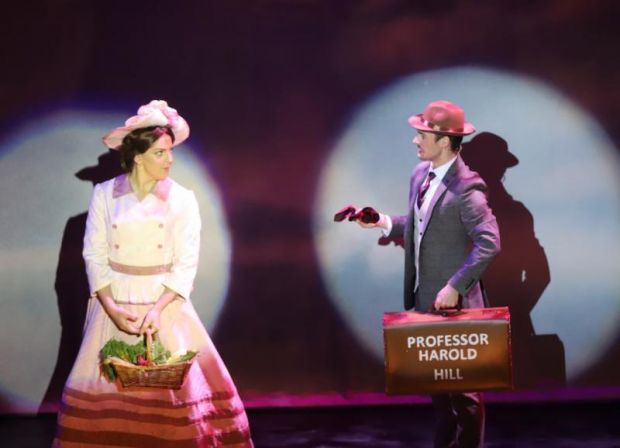
This sumptuous production of The Music Man is hailed to be the most lavish production in CenterStage’s history. Directors Michele Marcu and David Greenwood have demonstrated their commitment to pushing the boundaries of what is possible on stage and have left no detail unattended. Rather than portraying an era characterized by male dominance, the directors have highlighted the power and tenacity of the female inhabitants in River City. This can be seen in their portrayal of librarian Marian Paroo, who is depicted as a smart, independent woman who is able to handle her own business affairs. By highlighting the character’s resilience and determination, Marcu and Greenwood have succeeded in creating a more nuanced and realistic representation of women in the early 1900s.
David Greenwood’s timeless stage design is magnificent, meticulously crafted, and enthralling, reminiscent of the intricate sets found in both Hamilton and the Newsies. This production eschews digital screens in favor of elaborate wooden structures like scaffolding, bridges, decks, and staircases, along with sophisticated fly systems and props. Sets include the interior of a train, exterior and interior of the Paroo's house complete with piano (and authentic photos of the cast hanging on the walls), the interior of the town library (with trolleys full of books), the school gym (where the local ladies practice their classical dance and ribbon twirling), and a footbridge (where the two leads finally share a kiss, or two!). And the pias de resistance is a Conestoga wagon (symbolizing progress, excitement, and connection to the outside world) used to great effect during the Wells Fargo Wagon number. Hand-painted scrims, billowing swag curtains, and American bunting flags all contribute greatly to the overall character and visual impact of the performance.
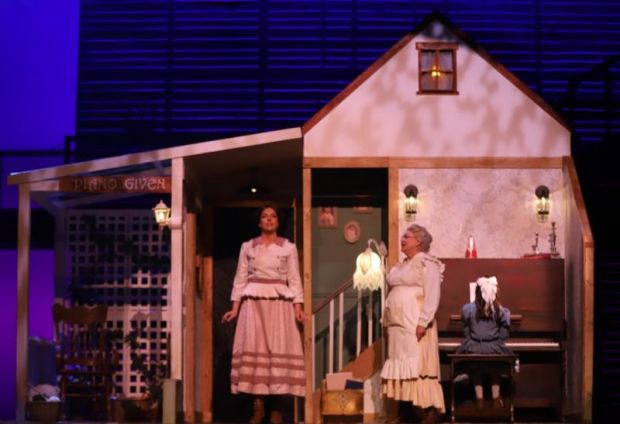
I believe the standout element of this production is the dancing. The quality of Lochlan Erard's choreography is evident in every step of the show. Each movement has been meticulously planned and executed, resulting in a polished and professional performance. Despite the adherence to traditional styles, the dance seamlessly transitions into a contemporary and playful demeanor at the blink of an eye, captivating the audience and keeping us on the edge of our seats. It had been mentioned to me that the Marian the Librarian scene alone required 30 hours of practice to learn the routine. Such commitment from everyone involved is truly remarkable! It deserved its own standing ovation! Other dance highlights included “(Ya Got) Trouble”, “Seventy-six Trombones”, “Shipoopi” and the comical classical/ribbon twirling dance performed by the Pickalittle (Talk-a-Little) ladies. Well done to all the dancers, led by Dance Captain Shaughn Pegoraro. Your dedication and skill shine through!
Bravo to Musical Director Gabriel Taburet and the exceptional 19-piece orchestra for their flawless performance of this highly challenging score. Special mention to the exceptional talent of the brass section, consistently delivering impressive notes. A remarkable outcome, particularly given that this is only Taburet’s second stint as a musical director. Notwithstanding the challenges of teaching such a large cast complex songs, featuring intricate rhythms and harmonies (including a barbershop quartet), Cate Dunstan has achieved a remarkable outcome, showcasing her outstanding prowess as Vocal Director.
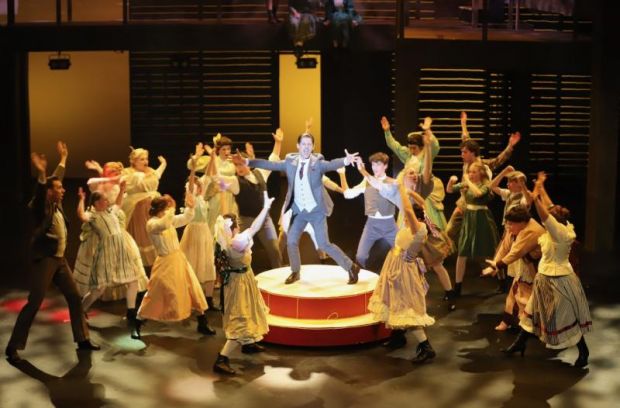
The exceptional craftsmanship and attention to detail displayed by Costume Coordinators Dawn Murdoch and Virginia Connell, along with their dedicated team, deserve commendation for the exquisite quality of the costumes. In addition to the Directors, it is evident that they have thoroughly researched the era and thoughtfully selected fabrics and colors typical of Iowa during this historical period. The addition of Nicole Plowman’s wigs and Zoe Smith’s hair and makeup designs enhance the intricate costumes with an extra touch of detail and authenticity.
The meticulous artistry of Lighting Designers Jack Pryce and Jason Bovaird from Moving Light Productions shines brightly throughout the performance. Their masterful work has infused the show with a captivating energy, achieved through a vibrant spectrum of colors that harmonize flawlessly with the overall mood. By employing silhouettes against billowing curtains, casting long hanging lights to illuminate the train’s interior and gymnasium, and heightening the impact of the brass band finale with dynamic lighting effects, they have enriched the production’s ambiance to a remarkable degree. The sound design executed by William McGuinness demonstrates a harmonious balance, ensuring that both dialogue and vocals remain clear amidst the orchestra and sound effects.
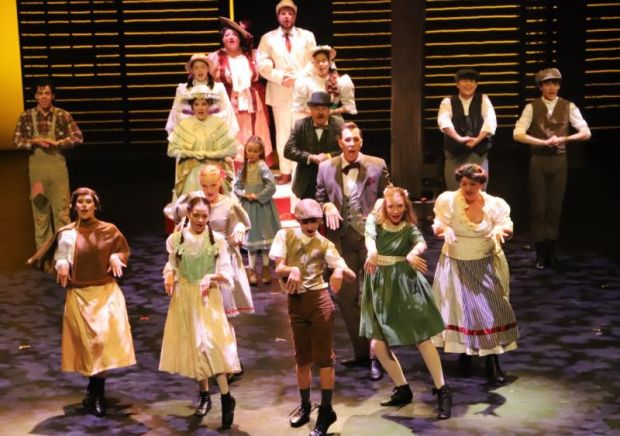
Jesse Simpson brings a fresh and youthful interpretation to the character of Harold Hill, the dynamic con man and traveling salesman. The fusion of his velvety vocals, engaging wit, nimble footwork, and offbeat demeanor, (reminiscent of Willy Wonka), breathes fresh life into the role for a contemporary audience. Instead of depicting Marian Paroo as a rigid librarian and piano instructor, Georgia Ellen portrays her as a woman of strength, resilience, independence, and unwavering spirit who refuses to be dictated to. Her enchanting Disney Princess-like vocals truly shone in her rendition of “My White Knight”. Ellen's more delicate side was unveiled as she sang “Goodnight, My Someone” and “Till There Was You”.
Terri Powell (Mrs. Paroo), Tim Maloney (Marcellus Washburn), Trent Inturrisi (Mayor Shinn) and Murray Plowman (Charlie Cowell), all showcased strong and vibrant personalities on stage. Their entrances were always captivating, bringing energy and life and occasional humour to the production. Significant comedic relief came from Jenn Stirk (Alma Hix), Zoe Rossbotham (Ethel Toffelmier), Jessica Wynhoven (Maud Dunlop), and Chanelle Tait (Mrs. Squires) through their unique movement, demeanor, and the amusing ribbon twirling routines led by Tammy Berry (Eulalie Mackechnie Shinn). Jules Hart (Oliver Hix), Joel Lane (Olin Britt), Jack Bartell (Euwart Dunlop) and Jack McPahil (Jacey Squires) performance was exceptional, showcasing their talent in handling the challenging harmonies and acapella singing required for their roles as the bickering school board members in the Barbershop Quartet.
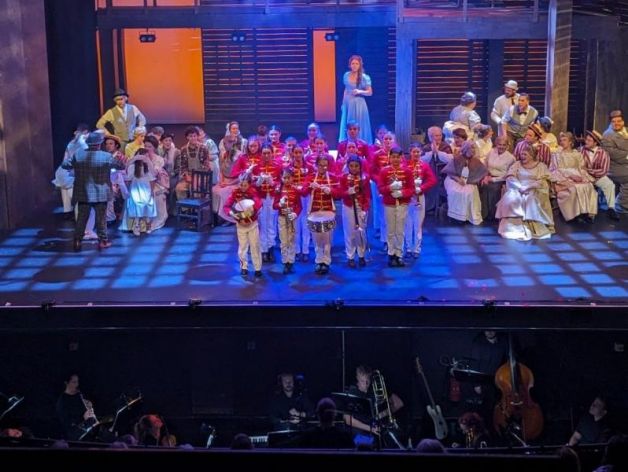
The Music Man boasts a large ensemble of talented youngsters under the age of 20. Special mention goes to Charlton Keogh (Winthrop Paroo), Emily McClure (Amaryllis), Flynn Wilkie-Clarke (Tommy), Chloe Lewis (Zaneeta Shinn) and Cassiana Marcu (Gracie Shinn) for their outstanding performances on opening night, showcasing remarkable vocals, acting, and dancing skills. They exuded confidence and captivated the audience with their talent! Keogh’s performance of “Wells Fargo Wagon” and “Gary, Indiana” was lively, exuberant, and authentic. Alternates include Archie Gaylard (Winthrop Paroo) and Aria McHenry (Amaryllis). The other performers in the ensemble (too numerous to mention here) also deserve praise for their outstanding talent and commitment to their respective roles. The nearly 70-member cast delivers an outstanding performance without any shortcomings, warranting a well-deserved standing ovation at the conclusion of the night.
CentreStage is to be congratulated on another top-notch production.
If you want to see ‘rows and rows of the finest virtuosos’ get along and see The Music Man.
Regional theatre doesn't get much bigger, bolder, better or brassier than this! Don't miss it!
Jonathan Cox
Photos supplied by David Greenwood
Subscribe to our E-Newsletter, buy our latest print edition or find a Performing Arts book at Book Nook.

